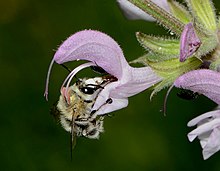Salvia hierosolymitana: Difference between revisions
add vernacular name |
m →top: http→https for Google Books and Google News using AWB |
||
| Line 15: | Line 15: | ||
'''''Salvia hierosolymitana''''', the '''Jerusalem salvia''' or '''Jerusalem sage''', is a herbaceous perennial native to the eastern Mediterranean, with populations in [[Cyprus]], [[Israel]], [[Jordan]], [[Lebanon]], [[Syria]], and the [[West Bank]].<ref>{{cite web|url=http://www.ars-grin.gov/cgi-bin/npgs/html/taxon.pl?407901|title=Salvia hierosolymitana Boiss.|date=10 July 2001|work=GRIN Taxonomy for Plants|publisher=USDA Germplasm Resources Information Network|accessdate=2 August 2010}}</ref><ref>{{cite journal|last=Ali-Shtayeh|first=Mohammed S|author2=Rana M Jamous |year=2008|title=Traditional knowledge of wild edible plants used in Palestine (Northern West Bank): A comparative study|journal=Journal of Ethnobiology and Ethnomedicine|publisher=BioMed Central Ltd.|pages=13|volume=4|issue=13|doi=10.1186/1746-4269-4-13|url=http://www.ethnobiomed.com/content/4/1/13|accessdate= 1 August 2010|pmid=18474107|pmc=2396604|display-authors=etal}}</ref> It typically grows in open fields, rocky soils, and among low-growing native shrubs. It was first described in 1853 by botanist [[Pierre Edmond Boissier]], with the epithet "''hierosolymitana''" referring to "royal, sacred Jerusalem". |
'''''Salvia hierosolymitana''''', the '''Jerusalem salvia''' or '''Jerusalem sage''', is a herbaceous perennial native to the eastern Mediterranean, with populations in [[Cyprus]], [[Israel]], [[Jordan]], [[Lebanon]], [[Syria]], and the [[West Bank]].<ref>{{cite web|url=http://www.ars-grin.gov/cgi-bin/npgs/html/taxon.pl?407901|title=Salvia hierosolymitana Boiss.|date=10 July 2001|work=GRIN Taxonomy for Plants|publisher=USDA Germplasm Resources Information Network|accessdate=2 August 2010}}</ref><ref>{{cite journal|last=Ali-Shtayeh|first=Mohammed S|author2=Rana M Jamous |year=2008|title=Traditional knowledge of wild edible plants used in Palestine (Northern West Bank): A comparative study|journal=Journal of Ethnobiology and Ethnomedicine|publisher=BioMed Central Ltd.|pages=13|volume=4|issue=13|doi=10.1186/1746-4269-4-13|url=http://www.ethnobiomed.com/content/4/1/13|accessdate= 1 August 2010|pmid=18474107|pmc=2396604|display-authors=etal}}</ref> It typically grows in open fields, rocky soils, and among low-growing native shrubs. It was first described in 1853 by botanist [[Pierre Edmond Boissier]], with the epithet "''hierosolymitana''" referring to "royal, sacred Jerusalem". |
||
It forms a mound of basal leaves that spreads to 2 ft, and slightly less in height. The ovate mid-green leaves are evergreen, lightly covered with hairs, and with a scalloped margin, growing 8-10 in long with prominent veining underneath. The 1 in or smaller flowers are a wine-red color, growing in widely spaced whorls, with 2-6 flowers per whorl. The lower lip is white, with wine-red spotting. The calyces are pea-green with red veins and bracts edged in red. The square stem of the 1 ft long inflorescences are also edged in red. Unlike many salvias, there is no odor when the leaves are crushed, and there is no known medicinal use of this plant.<ref name="Clebsch">{{cite book|last1=Clebsch|first1=Betsy|last2=Barner|first2=Carol D.|title=The New Book of Salvias|publisher=Timber Press|year=2003|page=145|isbn=978-0-88192-560-9|url= |
It forms a mound of basal leaves that spreads to 2 ft, and slightly less in height. The ovate mid-green leaves are evergreen, lightly covered with hairs, and with a scalloped margin, growing 8-10 in long with prominent veining underneath. The 1 in or smaller flowers are a wine-red color, growing in widely spaced whorls, with 2-6 flowers per whorl. The lower lip is white, with wine-red spotting. The calyces are pea-green with red veins and bracts edged in red. The square stem of the 1 ft long inflorescences are also edged in red. Unlike many salvias, there is no odor when the leaves are crushed, and there is no known medicinal use of this plant.<ref name="Clebsch">{{cite book|last1=Clebsch|first1=Betsy|last2=Barner|first2=Carol D.|title=The New Book of Salvias|publisher=Timber Press|year=2003|page=145|isbn=978-0-88192-560-9|url=https://books.google.com/books?id=NM0iwB8GrQYC&pg=PA145}}</ref> |
||
[[Image:Anthophora on Salvia 1.jpg|thumb|widthpx|Male ''[[digger bee]]'' (''[[Anthophora]] dufourii'') pollinating ''Salvia hierosolymitana'', [[Mount Carmel]], Israel]] |
[[Image:Anthophora on Salvia 1.jpg|thumb|widthpx|Male ''[[digger bee]]'' (''[[Anthophora]] dufourii'') pollinating ''Salvia hierosolymitana'', [[Mount Carmel]], Israel]] |
||
==Notes== |
==Notes== |
||
Revision as of 10:09, 23 October 2016
| Salvia hierosolymitana | |
|---|---|

| |
| Scientific classification | |
| Kingdom: | |
| (unranked): | |
| (unranked): | |
| (unranked): | |
| Order: | |
| Family: | |
| Genus: | |
| Species: | S. hierosolymitana
|
| Binomial name | |
| Salvia hierosolymitana | |
Salvia hierosolymitana, the Jerusalem salvia or Jerusalem sage, is a herbaceous perennial native to the eastern Mediterranean, with populations in Cyprus, Israel, Jordan, Lebanon, Syria, and the West Bank.[1][2] It typically grows in open fields, rocky soils, and among low-growing native shrubs. It was first described in 1853 by botanist Pierre Edmond Boissier, with the epithet "hierosolymitana" referring to "royal, sacred Jerusalem".
It forms a mound of basal leaves that spreads to 2 ft, and slightly less in height. The ovate mid-green leaves are evergreen, lightly covered with hairs, and with a scalloped margin, growing 8-10 in long with prominent veining underneath. The 1 in or smaller flowers are a wine-red color, growing in widely spaced whorls, with 2-6 flowers per whorl. The lower lip is white, with wine-red spotting. The calyces are pea-green with red veins and bracts edged in red. The square stem of the 1 ft long inflorescences are also edged in red. Unlike many salvias, there is no odor when the leaves are crushed, and there is no known medicinal use of this plant.[3]

Notes
- ^ "Salvia hierosolymitana Boiss". GRIN Taxonomy for Plants. USDA Germplasm Resources Information Network. 10 July 2001. Retrieved 2 August 2010.
- ^ Ali-Shtayeh, Mohammed S; Rana M Jamous; et al. (2008). "Traditional knowledge of wild edible plants used in Palestine (Northern West Bank): A comparative study". Journal of Ethnobiology and Ethnomedicine. 4 (13). BioMed Central Ltd.: 13. doi:10.1186/1746-4269-4-13. PMC 2396604. PMID 18474107. Retrieved 1 August 2010.
{{cite journal}}: CS1 maint: unflagged free DOI (link) - ^ Clebsch, Betsy; Barner, Carol D. (2003). The New Book of Salvias. Timber Press. p. 145. ISBN 978-0-88192-560-9.
